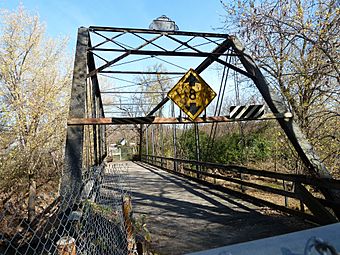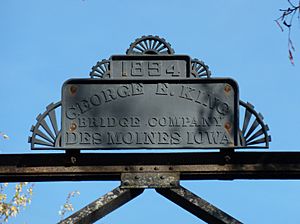Clinton Falls Bridge facts for kids
Quick facts for kids Clinton Falls Bridge |
|
|---|---|
|
Bridge No. L-5573
|
|

The Clinton Falls Bridge viewed from the west
|
|
| Lua error in Module:Location_map at line 420: attempt to index field 'wikibase' (a nil value). | |
| Location | Township Road 95 over the Straight River, Clinton Falls Township, Minnesota |
| Area | Less than one acre |
| Built | 1894 |
| Built by | George E. King Bridge Company |
| Architectural style | Pratt through truss |
| MPS | Iron and Steel Bridges in Minnesota MPS |
| NRHP reference No. | 96001613 |
| Added to NRHP | January 25, 1997 |
The Clinton Falls Bridge is a historic bridge in Clinton Falls Township, Minnesota. It's also known as the Old Mill Bridge or Bridge L-5573. This bridge crosses the Straight River. It's special because it's a great example of an early steel bridge design in Minnesota. In 1997, it was added to the National Register of Historic Places.
Contents
What is the Clinton Falls Bridge Like?
The Clinton Falls Bridge is a type of bridge called a Pratt through truss. Imagine a giant metal frame that supports the road. This bridge has one main section, or span. It rests on strong supports called abutments, which are made of concrete and limestone.
How is the Bridge Built?
The top part of the bridge, called the superstructure, is about 125 feet (38 meters) long and 22 feet (6.7 meters) wide. The road you would drive on is made of thick wooden planks. These planks sit on steel beams called stringers. The stringers are held up by even bigger steel beams called floor beams.
All these steel parts are connected using strong metal fasteners called rivets. The main parts of the bridge's frame, like the top bars and end posts, are made of steel channels. Other parts, like the diagonal bars, are made of special steel rods. There are also metal bars that help keep the bridge stable from side to side.
You can see a special metal sign, called a builder's plate, at each end of the bridge. This sign tells you who built it.
Bridge Condition and Changes
The bridge is mostly in its original condition. However, in 1975, new concrete was added to the limestone supports. This helped make the bridge stronger. There are also parts of an older bridge's supports nearby. This shows that a bridge has been at this spot for a long time.
History of the Clinton Falls Bridge
People started settling in the Clinton Falls area in the 1850s. The town grew because it had the first gristmill (a mill for grinding grain) in the county. This mill was very important to the community.
The Clinton Falls Bridge we see today is actually the second bridge built at this location. In 1867, the county decided to build a covered bridge here. It cost about $3,000. Some parts of that old bridge's supports might still be used in the current bridge.
Building the Current Bridge
In 1894, the local board decided to build a new "iron bridge" with steel parts. They hired the George E. King Bridge Company from Des Moines, Iowa. The old covered bridge was taken down in late September 1894. Workers quickly put up the new steel bridge. It was finished on October 2, 1894. People said it was "all iron and steel, except the planks and railing." The county helped pay for most of the bridge's cost.
Challenges and Preservation
Over the years, the town of Clinton Falls became smaller. The mill, school, church, and stores all closed. The bridge became one of the few old structures left.
In 1970, the bridge was found to be unsafe for cars. Repairs were estimated to cost about $3,000. The local board decided to close the bridge to all traffic. But people living on one side of the river were very upset. They needed the bridge to get around. A local businessman named Reuben Kaplan, who owned the Owatonna Tool Company, donated money to fix the bridge. This allowed new wood planks and railings to be put in.
The bridge was closed to traffic again in 1994, when it was 100 years old. Inspectors found that some of the steel parts were very rusty and thin. Fixing it would cost a lot of money. Because of this, local residents formed the "Save the Clinton Falls Bridge Committee." They wanted to raise money and protect the bridge as a historic site. They contacted the Minnesota Historical Society, which helped get the bridge listed on the National Register of Historic Places. The bridge is still closed to traffic today.
Why is the Clinton Falls Bridge Important?
The Clinton Falls Bridge is important because it shows how steel bridges were designed in Minnesota a long time ago. Bridges were very important for people settling in Minnesota. They helped connect towns and allowed people to travel and trade.
Evolution of Bridge Building
At first, bridges were often made of wood or a mix of wood and iron. By the 1880s, the "Pratt through truss" design, like the Clinton Falls Bridge, became very popular for long bridges.
Steel started to be used in bridges around this time. First, it was used for small connecting parts. But by 1895, steel had replaced iron in almost all parts of bridge building. Bridges from the 1890s, like the Clinton Falls Bridge, were among the first to use steel widely in Minnesota. This bridge is also special because it's the only remaining bridge in Minnesota built by the George E. King Bridge Company.


